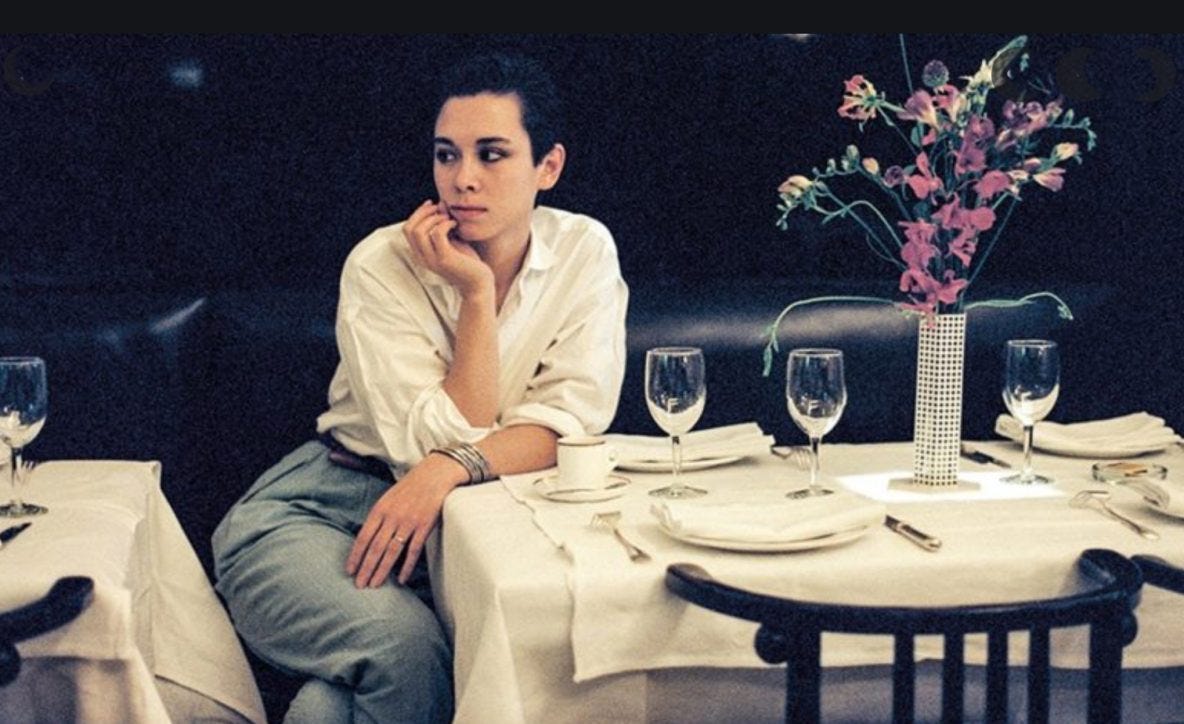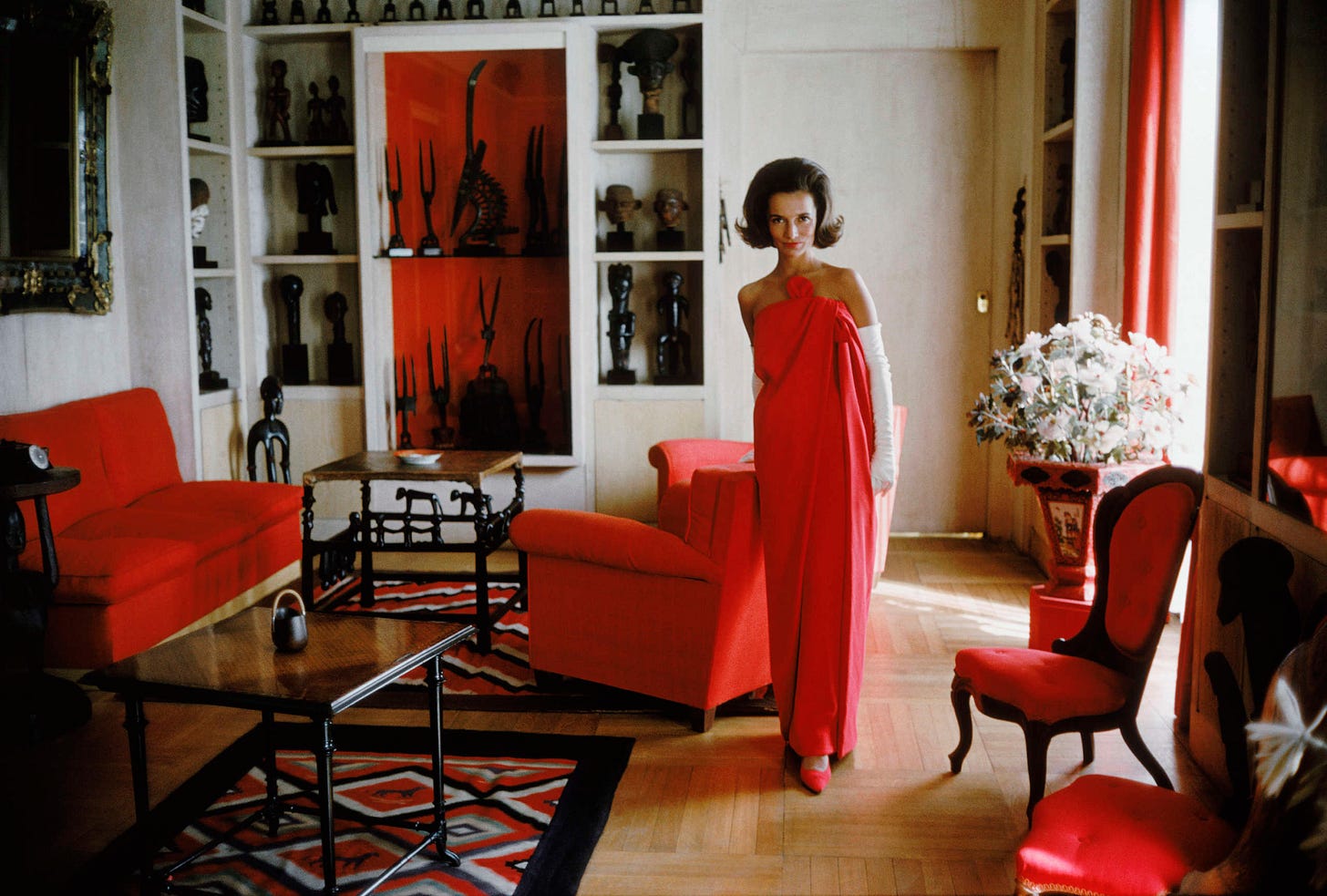It’s been almost a year since I first wrote this particular newsletter edition — and I still feel like many of the same sentiment remains, particularly off the back of The search for good taste is a trap from a few weeks ago.
I’m removing the paywall of this article and re-sharing since it.
If you have any thoughts, please comment below — it’s been one of my most popular newsletters, so I’m hoping it’ll resonate with you still, today.
Not to belie my vintage, but Alexa Chung’s style defined my generation. The shorts and breton tops and minidresses from Opening Ceremony and Antipodium. I will steadfastly argue that this was not ‘indie sleaze’.
She was a model-turned TV host on Popworld; hardly a cutting edge fashion platform, but there was something about how she haphazardly layered vintage blouses under overalls with granny-style knit cardigans that swept us all up and — what do the kids say? — had us in a chokehold.
I asked around — on the internet, and real life — who is the equivalent for now.
Hailey Bieber was a popular response. And I can see their thinking behind it, with her stylistic choices making a thousand cash registers ring (or, Shopify pings).
But to me, I wasn’t sure if she counts. I mean, she organises a photoshoot and a ‘glam team’ for her Halloween outfit. (I don’t hold it against her, it’s a Thing with celebrities now ie the Kardashians of course and a slew of others I can’t be bothered linking to right now.) Her wearing clothes is just amplifying a pre-existing style that is *currently* popular.
Or is it Matilda Djerf of 2022, whose hair has spawned a thousand TikTok how-to-gets and Dyson AirWrap purchases, or Jennifer Lawrence whose wardrobe has been overtaken by The Row.
But again, like Bieber, to me she’s just a reflection of what is happening in fashion now, rather than presenting a new way to do it. Someone else responded suggesting that there’s so many more niches now. There are, and there aren’t — you can really find your tribe out there, but for as many niches as there are, why is there a sense of the collective style where everyone buys the same Miu Miu item or gen Zs all aspire to wear a fitted baby T with a midi-skirt, their hair in braided pigtails. Don’t come for me — I like their styles but it’s the equivalent of a real life Pinterest board come to life. They’re looking at the same references we are. They just have more of an opportunity to dress for it, and to be photographed for it, and to make it their careers.
Is it just the romanticism of rose-coloured glasses that I think of style icons of yesteryear and their impact — maybe they also just reflected back what was happening at the time rather than being wholly unique, too?
To me, it means a personal style that is wholly, utterly, true to them. That when they wear even an ‘it item’, it becomes part of their being — you don’t notice the object, you notice the whole look. Like how there are some actors who transform into the character, and other times, it’s just Hugh Grant in a movie about a talking bear.
What made Chung, Chung, and what made Tina Chow so Tina Chow and Elsa Perretti so Elsa Perretti and Kate Moss and Gloria Guinness and Lee Radziwill and so forth and so forth, was that they were wholly and entirely themselves. They were a little bit less varnished, and not organising entire shoots to beam their imagery around the world. Back then there wasn’t so much #sponcon or ‘image architects’, and instead some of Kate Moss’ most famous outfits were from thrift stores, not designers. She plucked it out from a market, and made it entirely her own. (See below to hear her talk about some of her most famous looks. She holds thrift items to the same level of esteem as a runway sample.) Clothes as part of your personal style is a form of communication, and now you have the opportunity to call in help rather than doing it yourself.
Chung has since said that her style from her twentysomethings was “nothing more than a wonky impersonation of Jane Birkin”. How she’s dressing now is far more interesting and almost less uniform because she has the layers of time and experience of getting to know herself, rather than mimicking someone else. She may not be wearing facsimiles of what she wore in her 20s, but there is still is still that common else; that mix of ultra-girly and tailoring, a bit of an oddness with a classicism. It’s surprising and unexpected and witty and there’s just something a bit more to it. There’s no formula but there’s such a clear essence of her in everything she wears.
Taking inspiration from elsewhere is fine — it can spur you on, and be encouraging, or at least be a thought experiment. In a May 2023 episode of Puck’s podcast, Lauren Sherman charted the rise and fall of Refinery29.
What stayed with me was her dissemination of Refinery29’s success — and cause of failure. Its unique ‘tone of voice’, which in the world of marketing and content is the how a writer/brand/entity ‘speaks’ (yes, it’s weird that a non-human entity is described as speaking) differentiated Refinery29, but it also was easily replicable by other legacy media giants like Elle or Glamour. As these established names copied Refinery29’s tone of voice (TOV), it made Refinery29 just seem like everyone else. (This is of particular interest of me because these are my career worlds; I spent over 12 years in luxury fashion media and now I’m in retail, where my expertise is in brand and content strategy.)
I’ve seen work I’ve done copied — shoots, campaigns, articles. I’ve been sent other people’s work whose TOV rang a bit too similar to mine — I know I sound obnoxious saying that because there’s a lot of stuff out there and imitation is a form of flattery and hey sometimes it’s a mistake but sometimes when you know it’s a bit too close, IT FEELS WEIRD. “You’ve been duped!” encouraged a stylist friend, who said I should be taking it as a compliment because she felt a smug satisfaction when she sees her own work being poorly imitated, but maybe she’s a better human being than me.
In the film Finding Forrester, the student is encouraged by the experienced writer to type out one of the writer’s past works to start to get a feel of the words. You can of course practice through mimicry so that you can actually do your own thing but not like, actually DO IT, you know.
Originality — being *clap* yourself *clap* should be easy enough. There’s no better time like the present, when skirts of any length are ‘in fashion’, where there are mini bags and maxi totes all relevant to now — there are so many data points out there now that there’s not really that same pervasive trend as there once was. Straightforward, right? But it’s hard to actually know what is really you and what is there because of trends or peer pressure. Do you want the Alaia mesh flats or is it because of its ubiquity? This is where I find the discourse around quiet luxury and capsule wardrobes frustrating and honestly, so boring — the thought that all you need is that perfect pant/knit/coat from Brunello or Loro or The Row or wherever to feel complete.
‘Personal style’ advice in the form of Allison Bornstein or Tibi’s Amy Smilovic can help in articulating and guiding you to work out if you really do want <insert it item here> is for you, or have you just been ~influenced~. It shouldn’t be the be-all and end all of personal style though, because drilling it down to a strict set of rules misses the nuances of personal style — it’s the sort of friction, the off-ness which makes it more interesting.
Maybe it’s just on the side of fashion internet that I’m seeing, but there’s a bit of some backlash against the current discourse of personal style content — that it’s too rigid, that it wipes away what really makes us unique. They’re just a jumping off point and to help the truly clueless the tools and language to articulate where they want their style to go.
And you know what, this is controversial: not everyone has exemplary style and nor should they. And that’s okay. I don’t like a lot of people’s style out there nowadays, but at least it ignites a feeling. Most of the time I’m just indifferent, which is a much worse reaction because it’s bland. Someone wearing vintage Levi’s, a Uniqlo T-shirt and a trenchcoat doing affiliate links does not good style make, even with Bornstein or Smilovic’s help.
You can be whoever you want to be with your clothes. Everyday there’s the fun of choice; am I the classic, the minimalist, the maximalist, the innovator? They’re all who I am, but they flex up and down depending on how I’m feeling. That’s why I love vintage to chain stores to designer fashion and everything else between because I don’t want to be tied down to a single look, but I love the choice of deciding which sort of version of me I want to be that day.









"why is there a sense of the collective style where everyone buys the same Miu Miu item or gen Zs all aspire to wear a fitted baby T with a midi-skirt"
EXACTLY!!!! for all the chatter about how "there are no trends any more, just niches", why do certain niches become so dominant in the social media conversation that they aren't a niche anymore, giving the lie to the idea that there are "no trends"? What else am I supposed to think of the 8373rd influencer in 'perfect jeans' and 'perfect loafers' and that one specific style of droopy-shouldered blazer, which you know full well they'll ditch in a year once the runways and shops finally turn to a narrower shape?
There's a level of homogeneity to it all - even the 'tasteful' stuff from the 'right' labels, even if the need to constantly declare that you're in head-to-toe The Row/have renders the outfit as spiritually tacky as an outfit consisting entirely of logos (and frankly, antithetical to the way the founders of that label wear their designs). Fashion has always been a status game, but that's clearer than ever now, even if it happens to be tangled with the 'tell me something about myself' industrial complex (the "three words" stuff may be useful to a lot of people but frankly reminds me of a fashion version of the MBTI - at heart they are both pop psychology). Which might explain why I think so many people are lacking in actual style - it's easier to go along with a trend forecast or convince yourself that XYZ label/trend is "true to me" vs actually knowing myself and my tastes. All the women you named as icons - even Alexa, who was confident enough to own up to copying Jane Birkin - come across as having a very strong sense of self, or at least a definite and constant (if evolving) idea of their tastes.
Have you listened to this….Ezra Klein with Kyle Chayka on curating taste in a world of algorithms! https://www.nytimes.com/2024/01/09/opinion/ezra-klein-podcast-kyle-chayka.html